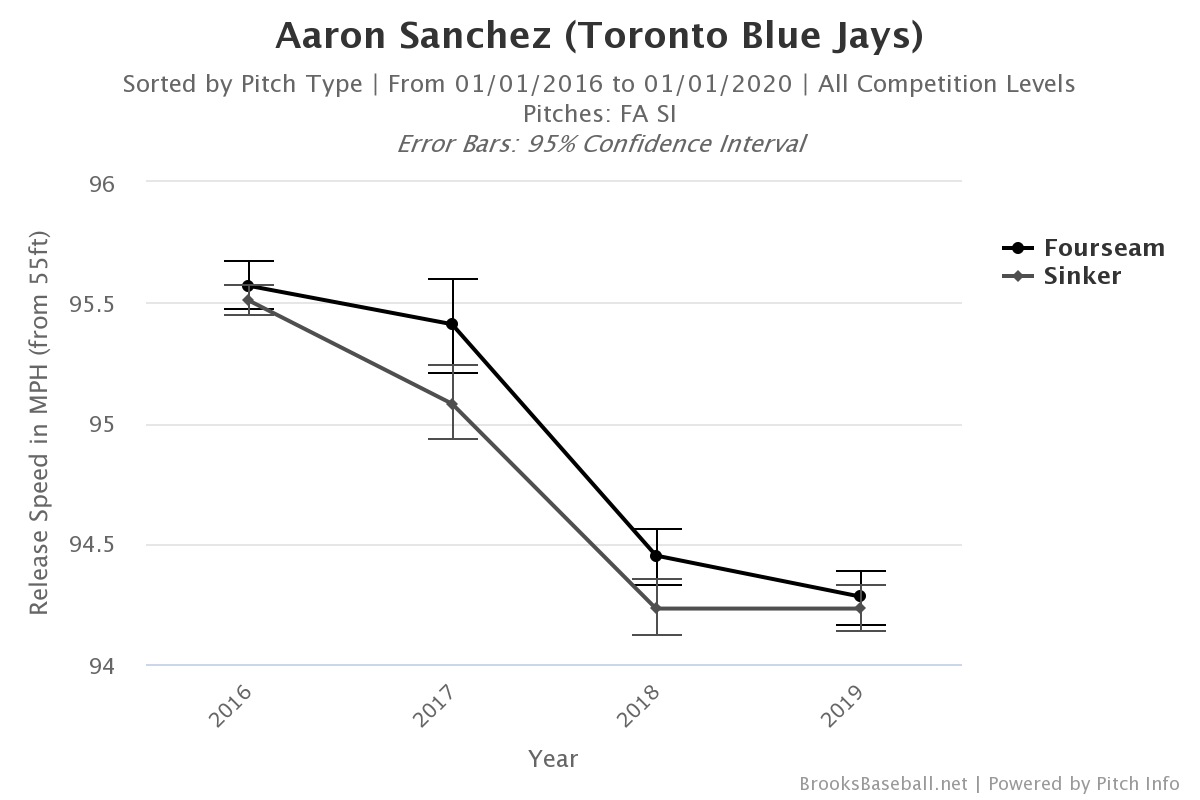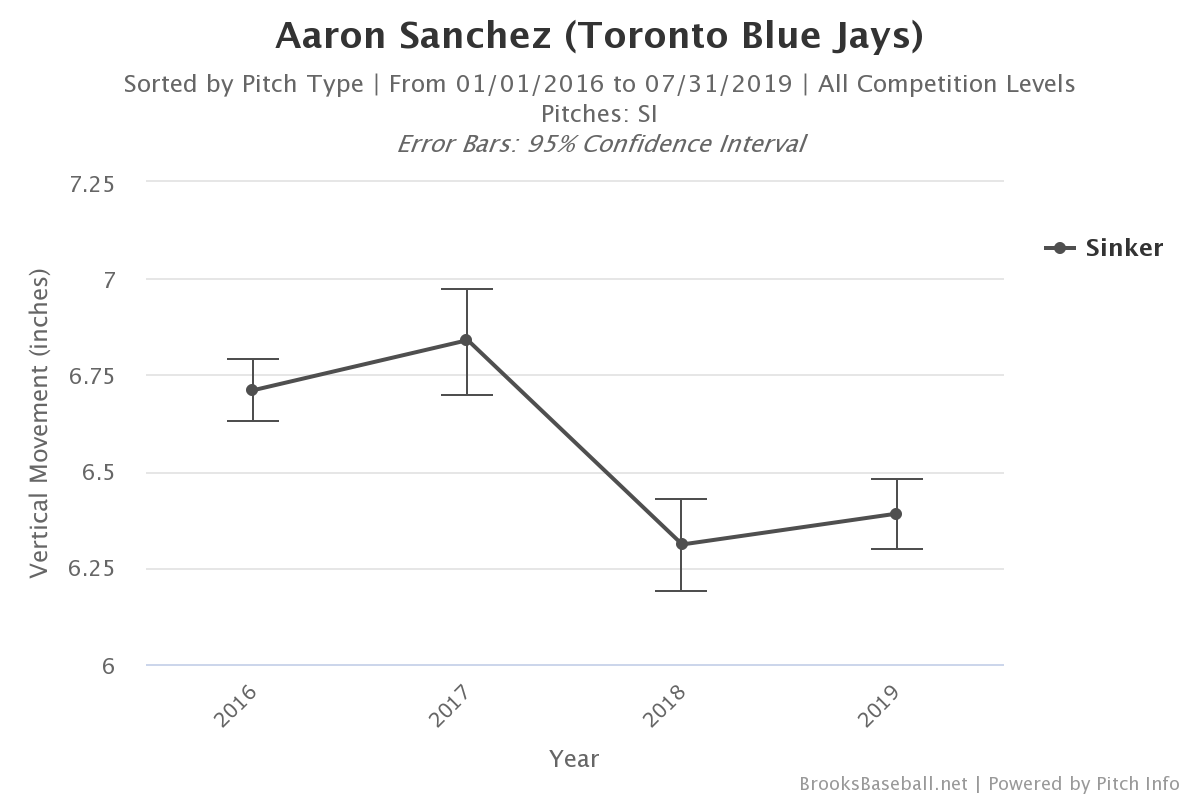TORONTO — When it comes to the incomplete career of Aaron Sanchez, the unanswerable question is what his remarkable 2016 season will look like when all is said and done. Was that a preview of how well his undeniable stuff would play as a front-line starter if only he was fully healthy? Or, was it the exception to the rule for a hard-throwing-yet-erratic right-hander destined for the bullpen, one who has walked at least four batters per nine innings in every professional season he’s pitched save for 2016?
In trading Sanchez now — as part of a trade deadline package for Houston Astros outfielder Derek Fisher, who, by the way, will play his next two months of baseball under an unfairly intense microscope from an aggrieved fanbase — the Toronto Blue Jays front office have told you exactly what they believe the answer to that question will be.
If there was legitimate confidence within the organization that he could soon pitch again as he did in 2016, that with a tweak here and an adjustment there he’d suddenly become the guy who won an American League ERA title again, Sanchez’s Blue Jays tenure wouldn’t have ended Wednesday. The Blue Jays wouldn’t have sold so low.
But the nearly three seasons that have followed all strongly suggest that version of Sanchez isn’t coming back. And the data from his current campaign, a season in which he’s remained healthy enough to make all of his starts for the first time since Barack Obama was U.S. president, indicates matters may be getting worse.
Combine that with the fact his remaining years of club control don’t time with Toronto’s potential return to contention in 2021, and that he’s due a raise this winter on his $3.9-million salary through arbitration — making him a less attractive asset to other teams, particularly if he’s moved to the bullpen — and you end up with Sanchez continuing his quest to rediscover his prior effectiveness with another organization.
That is the cold calculus Toronto’s front office ran. And while Blue Jays fans ought to always appreciate Sanchez’s brilliant all-star season, and should never forget the dominant relief appearances he made for the club during the 2015 playoffs, plus the pair of starts the following post-season, the club’s executives are not concerned with nostalgia. They are tasked with doing what’s best for the organization, damn any outrage. And, particularly when you consider how much the trust level between Sanchez and the team eroded over two seasons lost to frustrating, recurring injuries, it’s easy to see why they made the decision they did.
Of course, the transaction wasn’t about trading Sanchez. It was about acquiring Derek Fisher. But it wasn’t not about trading Sanchez, either. He was actively shopped prior to the Fisher trade, but the only value the industry presented was similar to what Toronto received in return for veteran relievers David Phelps and Daniel Hudson — low-ceiling, fringy prospects on the cusp of their mid-20’s lacking plus tools. Not the younger, high-upside, projectable athletes the Blue Jays covet.
It was packaging Sanchez with the controllable Joe Biagini and his high spin rate curveball that made the trade possible at all. And the inclusion of Cal Stevenson — an intriguing 22-year-old with strong minor-league on-base numbers, impressive contact ability and great makeup who projects as a fourth outfielder — that sealed it. The industry spoke loud and clear in how it regarded Sanchez, whose ERA has been north of a half-dozen since late-June. Teams weren’t lining up to buy low on a distressed asset. They were valuing Sanchez based on how he’s performed over the last 30-plus months.
That Sanchez’s career has arrived at this point is demoralizing for anyone who knows him. You can never fault his passion for what he does, nor can you detract from how intensely he cares for and competes with his teammates. He was a tremendously popular presence in Toronto’s clubhouse throughout his tenure, and as he departs the franchise you won’t hear any of the character concerns that were not-so-quietly whispered about Marcus Stroman when he was traded last week.
And there’s an argument to be made that Sanchez has been the victim of preposterously bad luck and, in some cases, advice. Persistent blister and finger issues derailed his ability to grip and effectively throw a baseball after 2016, and a series of prescribed procedures and remedies failed to correct the problems. Multiple surgeries, endless grip changes, a host of mechanical adjustments, a baffling incident catching his finger in a suitcase — it all conspired to rob him of what could have been an exceptional prime.
In light of all that, and the fact Sanchez is a likeable and good-natured homegrown product who has embraced the country of Canada with open arms since Toronto drafted him in 2010, it’s understandable why many fans were dismayed to see his Blue Jays career end so unceremoniously. But MLB evaluators are not so kind.
Sanchez has been, quite literally, the worst qualified starting pitcher across MLB this season. And even as he has put up better results the last couple weeks, striking out 20 while walking only one over his last three outings, the underlying trends haven’t been encouraging.
His last time out — when he allowed four runs on six hits over 5.2 innings against the Tampa Bay Rays, striking out 10 — Sanchez’s sinker averaged its lowest velocity of any start this season, while his four-seamer averaged its second-lowest. That’s not what you want to see from a pitcher whose fastball velocity has been diminishing steadily since his first full season as an MLB starter.

The vertical movement on his sinker was also diminished in that outing, averaging a drop more than an inch less than his season average, and more than an inch-and-a-half less than it featured in 2016. MLB clubs, practically all of them now run by analytically minded front offices, no longer scout the results. They scout the process. And Sanchez’s doesn’t suggest he’s about to turn a corner.

If anything, it affirms why he’s dead last among qualified MLB starters with a 6.07 ERA and 4.71 BB/9. Also, why Sanchez’s 39.2 per cent hard-hit rate is the highest of his career by a mile, nearly 10 points above where it sat during that remarkable 2016 campaign. And for those in the game who believe he’s better suited for a relief role, there’s the fact Sanchez’s velocity has steadily declined by the inning this season, which helps explain why his OPS against goes from .643 his first time through an order to .947 his second and .987 his third.

Of course, none of this means the Blue Jays had to give up on the possibility of Sanchez turning it around. He’s spent much of this season searching for the delivery and feel that allowed him to be so successful in the past after regularly altering his pitch grips and mechanics over the last two seasons while battling injury. It’s not impossible that with health he could suddenly find himself again.
And maybe Houston’s well-regarded R&D personnel can help. Justin Verlander’s career appeared to be on a downward plane when he arrived with the Astros and experienced an all-star resurgence in his mid-30s. Gerrit Cole’s 8.4 K/9 over his first 127 career starts has soared to 12.8 over 55 outings since joining Houston. Wade Miley — Wade Miley! — pitched to a 4.76 ERA between 2015 and 2018, but now has a 3.06 ERA in his first season with the Astros. Whatever the secret pitching sauce is, the Astros appear to have it.
You certainly won’t find anyone rooting against Sanchez thriving in Houston. His now-former teammates, Blue Jays personnel and, admittedly, those who cover the team, would all be thrilled to see the guy from 2016 re-emerge. It would be a nice result for a nice guy. There just aren’t many people betting on it, particularly those in MLB front offices. All we know is that Sanchez has the opportunity to prove them all wrong. And that the question of what 2016 was in his career will be answered someday, one way or another.
[relatedlinks]









